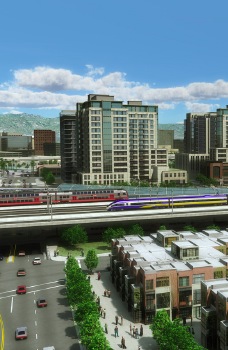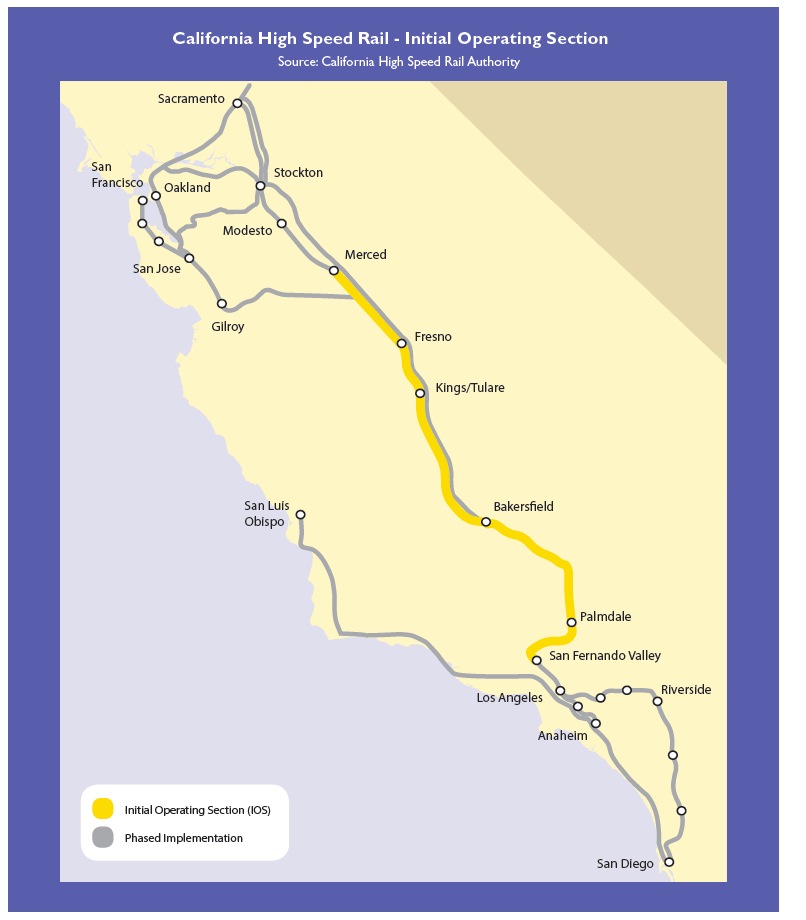UC BERKELEY: CENTER FOR LAW, ENERGY AND ENVIRONMENT
UCLA: EMMETT CENTER ON CLIMATE CHANGE AND THE ENVIRONMENT
 Executive Summary: High Speed Rail in the San Joaquin Valley
Executive Summary: High Speed Rail in the San Joaquin Valley
After decades of planning, high speed rail is coming to California. With a recently revised and more cost-effective business plan, officials hope to begin construction in 2013 on “Phase 1,” which will connect the San Francisco Bay Area to the Los Angeles Basin by 2028 for an estimated $68.4 billion. “Phase 2” will extend the system at a later date to other major population centers, such as San Diego, Sacramento, and the Inland Empire, with as yet undetermined costs.
High speed rail could offer numerous benefits to California. According to proponents, the system can reduce the need for costly new highway and airport expansions in California’s congested short-haul air markets and crowded intercity freeways, which are some of the busiest and most delay-prone in the nation – potentially saving $170 billion over 20 years. High speed rail could also help the state’s economy by supporting more convenient and efficient travel as well as increasing traveler productivity. If implemented properly with supporting land use policies, the system could also reduce air pollution and improve public health, as well as help California meet state climate change goals with electrified mass transportation that relies on an increasingly renewable-powered grid.
At the same time, the system has the potential to worsen California’s development patterns – and therefore the environment, economy, and public health. This risk is particularly a concern in California’s San Joaquin Valley (referred to as the “Valley”), where construction begins. The Valley has a history of building low-density, auto-oriented housing projects on valuable agricultural land, including “ranchettes” (rural housing on multiple-acre lots), leading to traffic congestion, poor air quality, and the ongoing loss of the region’s invaluable agricultural resources – a $43 billion per year industry. High speed rail could increase this growth and its negative effects around cities connected to stations. To heighten the challenge, the Valley has been politically divided over high speed rail while experiencing some of the worst effects from the recent recession.
Yet if Valley leaders can develop and implement supporting policies, the region could benefit economically and environmentally from the system and its six billion dollar state and federal investment. Proponents believe that construction will generate approximately 100,000 job-years over the next five years (a “job year” is defined as one job sustained for one year, while multiple job years could mean multiple jobs for one year or one job for multiple years), with most of that growth occurring in the Valley. The system could also create new business opportunities in Valley cities connected to the major economic hubs of the state. In addition, high speed rail could help address the region’s traffic congestion and severe air quality challenges and provide a faster alternative from Valley airports to the San Francisco Bay Area and Los Angeles and San Diego.
High speed rail representatives, local government officials, agriculture advocates, and business leaders gathered in Fresno in April 2013 for a discussion sponsored by the UCLA and UC Berkeley Schools of Law. The purpose was to identify the primary challenges to implementing high speed rail successfully in the Valley and to suggest strategies and policies. The group focused on four key barriers that could hinder effective high speed rail planning and implementation:
Four Key Barriers to Efficient Development around a High Speed Rail Foundation
1) Lack of a Valley-Wide Organizing Effort to Optimize High Speed Rail Decision-Making: the eight-county San Joaquin Valley lacks a collaborative mechanism, with business, community and government involvement, to focus on deciding, shaping, and mobilizing support for high speed rail policies and benefits.
2) Lack of Resources for Planning and Outreach for Station-Connected Development: Cash-starved local governments and planning departments lack the funds needed to plan for development connected to high speed rail, gather citizen input, and mobilize community support for station-connected plans.
3) Financial Support for and Lack of Limits on Auto-Oriented Development: many local governments in the region have historically tended to approve lower-density, single-family developments and ranchettes that require residents to drive to services and jobs, which leads to disinvestment in future high-speed-rail-connected areas, higher costs to municipal budgets, and unmet consumer demand for compact, walkable neighborhoods.
4) Lack of Financing for High-Speed-Rail-Connected Projects: high speed rail stations and connected communities require improved center-city neighborhoods and older urban corridors, where historic disinvestment and deteriorating infrastructure may make development projects and upgrades difficult to finance.
Solutions to Overcome the Barriers
This report identifies the steps that government leaders, businesses, and the public can take to ensure that California optimizes growth patterns around high speed rail. These stakeholders will need to:
- Enlist a Valley-wide collaborative entity, including business, community, and government leaders, to develop a vision for regional economic growth and environmental preservation tied to high speed rail, ensure that high speed rail decision-making supports that vision, and mobilize citizens to implement the policies necessary to realize it;
- Support local and regional planning efforts and outreach, including through computer modeling programs and identification of best practices and tools, to implement the vision;
- Demonstrate the costs of development patterns that do not support the regional high speed rail vision by compiling and modeling data on the impacts of this development on municipal budgets, agricultural productivity, and public health; and
- Utilize and support financing programs that can catalyze private investment in thriving, mixed-use pedestrian, bike, and transit-accessible development projects that are connected to mobility hubs and high speed rail stations.
The report contains a summary roadmap of these and other proposed solutions, an overview of high speed rail policies and potential impacts, and a detailed explanation of each barrier and solution.
Download full version (PDF): A High Speed Foundation
About the Berkeley Center for Law, Energy and Environment
clee.berkely.edu
The Center for Law, Energy & the Environment (CLEE) at Berkeley Law develops policy solutions to the most pressing environmental and energy issues at the state, local, and national levels. CLEE is the heart of Berkeley Law’s environmental law program, organizing events with the many student groups on campus and working with our environmental and energy alumni.
About the UCLA Emmett Center on Climate Change and the Environment
law.ucla.edu/emmett
Founded in 2008 with a generous gift from Dan A. Emmett and his family, the Center is the nation’s first law school center focused exclusively on climate change. The Emmett Center is dedicated to studying and advancing law and policy solutions to the climate change crisis and to training the next generation of leaders in creating these solutions. The Center works across disciplines to develop and promote research and policy tools useful to decision-makers locally, state-wide, nationally and beyond.
Tags: Berkeley, CA, California, Center for Law Energy & Environment, CLEE, Emmett Center on Climate Change and the Environment, High Speed Rail, HSR, Los Angeles, UC Berkeley, UCLA, University of California






 RSS Feed
RSS Feed